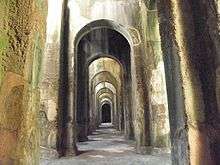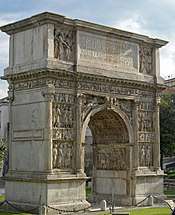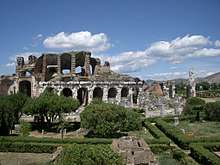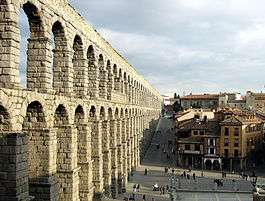Aqua Augusta (Naples)
The Aqua Augusta, or Serino Aqueduct (Italian: Acquedotto romano del Serino), was one of the largest, most complex and costliest aqueduct systems in the Roman world; it supplied water to at least eight ancient cities in the Bay of Naples including Pompeii and Herculaneum.[1] This aqueduct was unlike any other of its time, being a regional network rather than being focussed on one urban centre.[2]
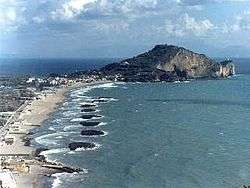
Route of the aqueduct

The route of the aqueduct[3] is well known thanks to the writings of two Italian engineers,[4] who were asked to see if it could be brought back in use as the main water supply of Naples in the 16th and 19th centuries.
There were ten branches, seven of which were for cities while three were for some of the numerous luxurious villas in this area popular with rich Romans, such as the Villa Pollio at Posillipo.[5] Including the branches, the total length of the aqueduct was approximately 140 kilometres (87 miles), making it the longest Roman aqueduct, with the possible exception of the Gadara Aqueduct, until the 5th century AD when the Valens Aqueduct was extended in Constantinople. The Aqua Augusta was one of the most difficult and costly aqueducts ever constructed by an ancient civilisation.[6] Despite its size and complexity, the Aqua Augusta is today largely unknown as a major monument because most of it is underground.
The aqueduct's source, the Fons Augusteus (now known as Acquaro-Pelosi), was in the Terminio-Tuoro mountains near the modern town of Serino not far from the city of Avellino and at 376 metres above sea level. One of its main terminations was the enormous Piscina Mirabilis at the naval base and port of Misenum.
Since the aqueduct traversed such a distance, many difficulties were encountered when building it: two-kilometre-long tunnels were cut through mountains, and there was ground movement near the coast due to volcanoes and a sea crossing was needed to the island of Nisida.
There is evidence that a large number of private users were members of the Rome senatorial class. In Rome, a letter from the emperor was required to gain a private connection and so it seems that imperial favour was also a factor in accessing the Augusta's water.
History
The Emperor Augustus (or more likely his close friend and ally Agrippa) had the Aqua Augusta built between 30 and 20 BC.[7]
During the war with Pompeius, Augustus ordered the construction of the Portus Julius harbour complex just west of Puteoli. Later, this harbour was seen as less ideal for the navy because of silting problems and a new major naval base was built further west at Misenum, where two lakes were connected to become the basis of the western Mediterranean war fleet. Large quantities of fresh water were needed for the base itself and for the ships, which must have been one of the reasons why Augustus had the new aqueduct built.[8] The main cistern filled by the aqueduct is the Piscina Mirabilis in Misenum.
Such a major monument required constant maintenance; there were major repairs in the Flavian period (1st century AD) with the addition of parallel tunnels and the Emperor Constantine also engaged in a massive restoration documented on an inscription tablet[9] discovered in Serino and dated to AD 324. The destinations listed are: Nola, Acerrae, Atella, Naples, Pozzuoli, Baiae, Cumae, and Misenum.
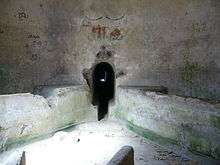
The cities of Pompeii, Herculaneum and Stabiae were also originally supplied by the aqueduct but being destroyed and covered by the eruption of Mount Vesuvius in 79 AD they did not appear on this list. The next major eruption in 472 AD left the aqueduct covered in ash and 3.5 km of the duct collapsed because of this. This cut off the supply of water to all the towns except Nola and Acerrae. The poor administrative and economic situation in Campania at this time, and Italy in general, prevented major repairs to the Augusta. Written references to aqueducts in Naples after this time only refer to other aqueducts that were now in the area.
In modern times, parts of the aqueduct, in addition to the Piscina Mirabilis were vital to the region's survival during World War II. Many locals used the areas as air-raid shelters.
Visible remains
There are few visible remains of the aqueduct today, although much of it still exists below ground. Traces of the original structure may be found at a number of sites in and around Naples.
These include:
- two parallel sections in Palma Campania (Tirone District), north of Pompeii[10]
- supporting wall for an aqueduct section at Muro d'Arce 3.8 km SE of Tirone
- the two parallel Ponti Rossi aqueduct bridges
- two joining aqueduct bridges in Rione Sanità[11]
- a section next to the Crypta Neapolitana in the Parco Vergiliano at Piedigrotta where it occupied a parallel tunnel
- the well-preserved Piscina Mirabilis at Misenum. This is one of the largest such reservoirs on an aqueduct known in the Roman Empire and survives almost intact to this day. It was probably intended for a large villa, or possibly as a strategic water resource for the naval base though it lies about 1 km distant.
- arches of the aqueduct have been identified in cellars of houses in Naples[12]
Literary allusions
It features prominently in the novel Pompeii by Robert Harris, whose protagonist is a water engineer ("Aquarius") sent from Rome to maintain the aqueduct in AD 79 during the time around the eruption of Mount Vesuvius.
See also
- Roman aqueducts
- Roman engineering
- Roman technology
- List of Roman cisterns
References
- "Archived copy". Archived from the original on 2007-09-27. Retrieved 2007-08-20.CS1 maint: archived copy as title (link)
- Historical development of the Augustan Aqueduct in Southern Italy: twenty centuries of works from Serino to Naples; G. De Feo and R.M.A Napoli, Water Science & Technology Water Supply, March 2007
- Aqua Augusta - Serino (Italy): http://www.romanaqueducts.info/aquasite/
- Pietro Antonio Lettieri 1560, Felice Abate 1840, Abate 1842, Abate 1862, Abate 1864.
- P. Papinius Statius, Silvae Book II: A Commentary, Harm-Jan Van Dam - 1984, ISBN 9004071105
- The Aqua Augusta and control of water resources in the Bay of Naples Duncan Keenan-Jones, Macquarie University, Australasian Society for Classical Studies Conference 31, Perth, Australia 2010
- Hodge, A.T., Roman Aqueducts & Water Supply, 2nd ed. London: Duckworth.
- Passchier, C.W. and Schram, W.D. (2005). Serino (Italy). Aqua Augusta
- "Epigraphik Datenbank". Db.edcs.eu. Retrieved 8 September 2018.
- Lorenz, Wayne (June 2011). "Pompeii (and Rome) Water Supply Systems". Wright Paleohydrological Institute. p. 20. http://wrightpaleo.com/wordpress/wp-content/uploads/2011/11/Pompeii-June.pdf
- Francesco Colussi; Carlo Leggieri (2016). "L'acquedotto augusteo del Serino nell'area Vergini-Sanità a nord di Neapolis: identificazione e studio di due ponti-canale" (PDF). Proceedings of 2nd International Conference of History of Engineering (in Italian).
- Pompeii's Final Hours: New Evidence, https://www.channel5.com/show/pompeiis-final-hours-new-evidence/
- Hodge, A.T. (2001). Roman Aqueducts & Water Supply, 2nd ed. London: Duckworth.
